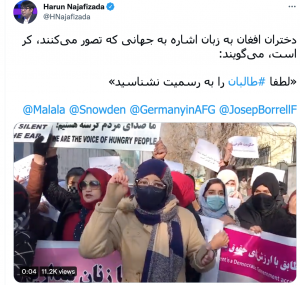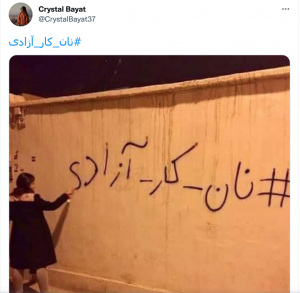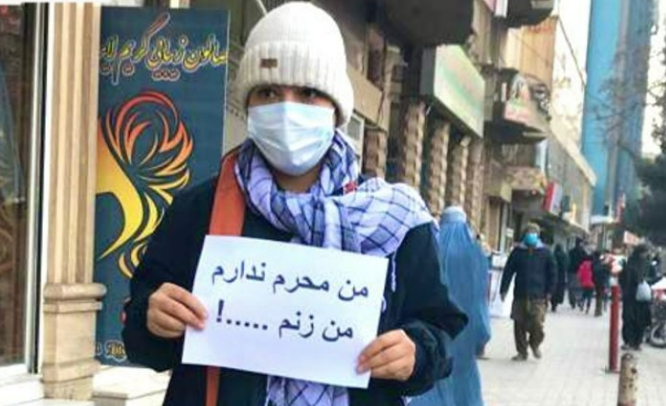Afghanistan’s Women: From Challenging ‘No Space’ to Being Silenced
‘When we reached the main street, the Taliban opened fire to disperse us. It felt as if it was raining bullets on us…’
-Sana, Protestor
Since the fall of Kabul to the Taliban in August 2021, women have been at the forefront of a lively civic resistance against the militant group that is deeply invested in religious fundamentalism and patriarchy. These protests have caught the attention of the world. As a woman from Afghanistan, I often get asked the question: “Why have women not mobilized this strongly before?”
In my view and in the words of Marnia Lazreg, women’s organizing and resistance was an absolutely ‘rational response to an otherwise irrational historical situation.’[1] However, to understand ‘the internal dynamics of women’s acts, agency and resistance’[2], I listened to women in Afghanistan themselves by conducting interviews in January with those who have been at the frontline of protests in Kabul, Herat, Panjshir and Nimroz. All have previously had important roles and positions in the government and civil society organizations, and currently are deprived of their right to work. They are also members or founders of various groups such as Junbesh Zanan Muqtader (The Movement of Powerful Women of Afghanistan), and Junbesh Tagheer (Change Movement), Junbesh Zanan Khudjosh (Self-directed/Autonomous Women’s Movement) that work as a mechanism for women’s empowerment, mobilization and organization.[3]
A few days after the Taliban takeover many protests took place across Afghanistan. The first reported women’s protest in Kabul occurred on August 17. Women asked “for their rights, the right to work, the right for education and the right to political participation.” These protests were followed by a Taliban representative’s promise to protect women’s rights. Nevertheless, according to Human Rights Watch, “every day brings further evidence that they are implementing a massive rollback of women’s rights.”
Following the fall of Kabul, the Taliban whitewashed the pictures of women across its neighborhoods. It was supposed to send a message that the removal from public view would not be limited only to their images. In September 2021 the Taliban issued a decree that ordered female employees to stay at home and effectively banned secondary education for girls. In the same month, the Women’s Affairs Ministry was abolished. The Taliban’s Ministry of Education made gender segregation and wearing the niqab mandatory for universities. In November, the Taliban banned women from appearing on TV shows and in movies. Most recently, in December, women were barred from traveling without a male chaperone. For over six months, women in Afghanistan have protested each and every restriction, despite being assaulted, tear gassed, beaten and whipped. In doing so, they have violated the September ban on impromptu protests.
The ban on impromptu protests was used as a form of social control to silence women and restrain women’s organizing. Masuda, one of the co-organizers of the protests in Herat, a former employee of the Directorate of Women’s Affairs in Nimroz said: “The Taliban are scared of our (Afghan women’s) voices.”[4] The Taliban’s detention of protestors attests to this fact. They detained 40 female protestors in September from Mazar-Sharif, many of whom were tortured and executed, and only a few of whom were released. The Taliban detained four other protestors including Tamana Paryani, Mursal Ayar, Zahra Mohammadi and Parwana Ibrahimkhel from Kabul later in January. While denying involvement at first, the Taliban released them on February 12. Many other have been detained. According to Masuda, the Taliban detained a woman and the only man who had protested in the second protest in Nimroz in September, torturing and filming them as they pledged to never question the Islamic Emirate again.[5] Khatera, a former gender representative at the Ministry of Education, said she had participated in 11 protests so far. At one of the protests, she was tear gassed and beaten by the Taliban and as a result had had a miscarriage. The incident seemed to have affected her relationship with her husband deeply. This did not stop her, though, she still continued protesting. She said:
Both home and outside are now bitter for me [… ] Despite this I continue fighting. If it wasn’t for our protests, some countries would have already recognized the Taliban government. In one of the protests a Talib confronted me and told me: you have made us darbadar (bedraggled), no government recognizes us because of your protests.[6]
While the return of the Taliban has restricted the public spaces for women, they no longer have a safe space at home either, with the patriarchy flourishing under Taliban rule. The crumbling economy and rising unemployment mean many men are also confined at home, putting women in a position of double deprivation. It is clear from what women say that the Taliban are extremely fearful of women’s voices as they challenge them and undermine their ‘legitimacy.’ Women’s autonomous movements have had an important role in bringing women’s issues to the mainstream agendas of international organizations and institutions such as the United Nations and European Parliament. Sana, a former civil society activist and entrepreneur stated:
After the impromptu ban on protests, we were told with approval we could organize our protests. Nevertheless, despite having permission, our protests are countered with violence and we are told we are not allowed to protest when we go to the protest venue. In contrast, the protests organized by the groups affiliated to the Taliban run smoothly.[7]
Despite the horrifying circumstances, women are not only maintaining agency and autonomy, they are creating counter-spaces for survival and resistance in the midst of hopelessness and uncertainty. In the words of Shalhoub-Kevorkian, they are challenging ‘the doctrine of “no safe haven”’, and hence no space.[8]
The literature describes counter-spaces as a process through ‘which groups reclaim spaces within dominant structures.’[9] Feminist counter-spaces are constructed to articulate resistant politics.[10] The creation of counter-spaces, though, isn’t an unfamiliar notion for the women of Afghanistan, like women in other conflict zones. Women in Belgrade during the civil war resisted violence by storytelling,[11] while Palestinian women create new venues for resistance as their houses are ravaged by Israeli occupation.[12] Afghanistan’s women resisted the Taliban during their first rule in various ways. One of these women was my maternal grandmother, who risked her life to deliver aid to remote regions of Faryab. Many other women organized secret schools in their basements. Under the current regime, women are risking their lives by running underground schools, as girls are barred from attending secondary school. According to Shalhoub-Kevorkian, ‘women’s ways of healing, helping and resisting are not based on hegemonic logic, but rather are multiple and complex.’[13] After the impromptu ban on protests, women of Afghanistan employed alternative methods as a means to resist the Taliban. Zahra, a former military commander, stated that: ‘We changed the ways in which we resisted after the ban on impromptu protests and carried out our protests at home, held our banners and chanted our slogans by posting videos on social media.’[14] Masuda on the other hand stated that:
Women in Nimroz can’t protest the Taliban publicly since it is a small city and one gets easily recognized. So we protest them by taking an active role in collecting evidence and documenting their war crimes. We stay connected with women in other provinces and report what they experience to media organizations. We also protest them by writing, we recently wrote a letter to the United Nations.[15]
Similar stories are shared by other women in smaller provinces.
Another example of women’s resistance was the Yalda Night (winter solstice) celebration, in which they read poetry and displayed the traditional attire of different ethnic groups in Afghanistan in response to the Taliban’s enforcement of a female dress code. Women also used sign language to tell the world not to recognize the Taliban in a protest on December 28 that went viral on social media.

Caption: Afghan girls in sign language say to the world they think is deaf: “Please do not recognize the Taliban”
On January 1, a woman went out dressed as a man holding a piece of paper that wrote ‘I am a woman, I don’t have a mahram (a male relative/escort).’ Another group of protestors, meanwhile, turned from daytime protests to writing their demands on the walls of Kabul at night. Murals too became a part of the counter-space, counter-discourse and women’s resistance. As women’s public spaces for advocacy and activism disappeared, women’s efforts have been directed towards creating alternative spaces and discourses to counter the restrictions of the Taliban.
Studies show that in contexts of conflict and uncertainty women have the capability to respond in extraordinary ways, redefining their gender norms.[16] Many of these protests not only championed women’s interests and rights but those of men as well and were inseparable from the civic and political concerns of the people of Afghanistan. The banners at the protests read, ‘Food, Work, Freedom’, ‘We Are the Voice of Hungry People’, ‘Stop Panjshir Genocide’ and ‘Stop Killing Former Soldiers and Government Officials’, given the forced disappearance and extrajudicial killing of former government officials and soldiers taking place across the country.

Caption: A mural that reads: Food, Work, Freedom
Sana was among a group of women who travelled from Kabul to Panjshir to protest the killing of a young boy who had no ties to the former government by the Taliban. She said house raids and the killing of young men are happening all across Panjshir and other rural regions.[17] She was strongly against demanding rights from the Taliban and stated that:
When you demand rights from them (Taliban) it means that you recognize them as a legitimate authority. Also how can you demand rights for women when everyone else including men are denied their rights too?[18]
According to Fetrat, fear plays ‘a significant role in the ways that Afghan women mobilize, resist, and take the lead’.[19] She states that the fears of Afghan women are rooted in the past (the previous Taliban regime).[20] But they also affect their present, and how they foresee the future. One of the interviewees Masuda said that:
We have already experienced the darkness of the Taliban rule in the past, we have seen how they clamped our rights from us and how they reduced us. This sense of fear and apprehension from the past is the reason we stand against them.[21]
Sana on the other hand said that:
Hearing they (Taliban) have banned women from work and public spaces is one thing and experiencing it directly is another. The Taliban have already shown how they govern once in the 90s, and it would be disgraceful if our future is the same as 20 years ago.[22]
While fear (of the past and what lies ahead in the future) was an important catalyst of autonomous organizing in the last six months, it also gradually reduced the number of protests. Faced with abduction, violence and death threats the streets of Kabul have seen no rallies in recent weeks.
Another, more recent tactic of the Taliban to silence women’s voices has been to discredit them and their activism through the release of confessional videos of women who had been abducted from a safe house in Kabul and who were then forced to declare that they were encouraged by Western-based activists to play the victim in order to gain asylum. In a recent interview, one of the female activists who has been in touch with the families of the abducted protesters said:
They raided the safe house, tortured and beat the women and then forced them to confess. They have released some but they have kept some in custody still although they have already been interrogated. These women (us) were supported or encouraged by no one outside, although we receive support on social media. But no, we have not been told by anyone to go and protest. These were self-driven and autonomous movements. We protested for what we actually protested for. The protests too were not against the Emirate, the protests were civic, women demanded rights, they demanded the release of abducted women. The confessional videos were truly forced. We did not deserve it, our efforts shouldn’t have been thrown in the dust.[23]
As Zahra stated:
Despite our salient activism against violence and male-domination, we have been judged and labelled unjustly by many. They say that we women protest in order to create a case to be evacuated from Afghanistan. Our purpose is solely to achieve our fundamental rights and is against misogyny and extremism.[24]
Following our last conversation in January, I have not been able to contact Zahra.
Nazeela Elmi studied Political Science and International Relations in Turkey, at TED University in Ankara, and also spent a semester in Germany, at Leipzig University, on an Erasmus Exchange program. Nazeela has worked on development and humanitarian projects, including programs for rural women in Afghanistan and Afghan women in Turkey with IOM and Embassy of Afghanistan in Ankara and has crowd-funded financial resources for displaced families in Faryab, Afghanistan. She has articles published in English, German and Turkish.
References
[1] Marnia Lazreg, “The Eloquence of Silence,” 2018, https://doi.org/10.4324/9781315232096.
[2] Nadera Shalhoub-Kevorkian, “Counter-Spaces as Resistance in Conflict Zones,” Journal of Feminist Family Therapy17, no. 3-4 (2005): pp. 109-141, https://doi.org/10.1300/j086v17n03_07.
[3] Sana (pseudonym), WhatsApp Conversation January 8, 2022.
[4]Masuda (pseudonym), WhatsApp conversation with the author, Jan 5, 2022.
[5] Masuda (pseudonym), WhatsApp conversation with the author, Jan 5, 2022.
[6] Khatera (pseudonym), WhatsApp conversation with author, January 6, 2022.
[7] Sana (pseudonym), WhatsApp Conversation January 8, 2022.
[8] Nadera Shalhoub-Kevorkian, “Counter-Spaces as Resistance in Conflict Zones,” Journal of Feminist Family Therapy17, no. 3-4 (2005): pp. 109-141, https://doi.org/10.1300/j086v17n03_07.
[9] Sarah E. Dempsey, Patricia S. Parker, and Kathleen J. Krone, “Navigating Socio-Spatial Difference, Constructing Counter-Space: Insights from Transnational Feminist Praxis,” Journal of International and Intercultural Communication 4, no. 3 (2011): pp. 201-220, https://doi.org/10.1080/17513057.2011.569973.
[10] Ibid.
[11] Marguerite R. Waller, Jennifer Rycenga, and Zorica Mrsevic, “CHAPTER 5 The Opposite of War Is Not Peace —It Is Creativity,” in Frontline Feminisms: Women, War, and Resistance (New York: Routledge., 2012), pp. 47.
[12] Nadera Shalhoub-Kevorkian, “Counter-Spaces as Resistance in Conflict Zones,” Journal of Feminist Family Therapy17, no. 3-4 (2005): pp. 109-141, https://doi.org/10.1300/j086v17n03_07.
[13] Nadera Shalhoub-Kevorkian, “Counter-Spaces as Resistance in Conflict Zones,” Journal of Feminist Family Therapy, 17, no. 3-4 (2005): pp. 109-141, https://doi.org/10.1300/j086v17n03_07.
[14] Zahra (pseudonym), WhatsApp conversation with the author, Jan 5, 2022.
[15] Masuda (pseudonym), WhatsApp conversation with the author, Jan 5, 2022.
[16] Nadera Shalhoub-Kevorkian, “Counter-Spaces as Resistance in Conflict Zones,” Journal of Feminist Family Therapy17, no. 3-4 (2005): pp. 109-141, https://doi.org/10.1300/j086v17n03_07.
[17] Sana (pseudonym), WhatsApp Conversation January 8, 2022.
[18] Sana (pseudonym), WhatsApp Conversation January 8, 2022.
[19] Fetrat, Mubareka Sahar. “An Affective Reading of Fear in the Period of Peace Process with the Taliban: Highlighting Afghan Women’s Subjectivities During Uncertainties.” Thesis, Central European University, 2020.
[20] Ibid.
[21] Masuda (pseudonym), WhatsApp conversation with the author, Jan 5, 2022.
[22] Sana (pseudonym), WhatsApp Conversation January 8, 2022.
[23] Sana (pseudonym), WhatsApp Conversation February 25, 2022.
[24] Zahra (pseudonym), WhatsApp conversation with the author, Jan 5, 2021.




